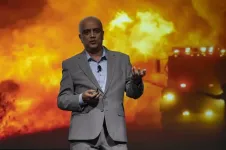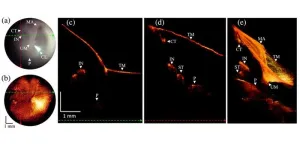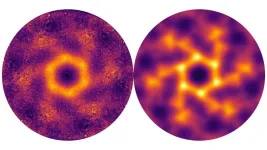(Press-News.org) When NASA’s Double Asteroid Redirection Test (DART) spacecraft collided with an asteroid moon called Dimorphos in 2022, the moon was significantly deformed—creating a large crater and reshaping it so dramatically that the moon derailed from its original evolutionary progression—according to a new study. The study’s researchers believe that Dimorphos may start to “tumble” chaotically in its attempts to move back into gravitational equilibrium with its parent asteroid named Didymos.
“For the most part, our original pre-impact predictions about how DART would change the way Didymos and its moon move in space were correct,” said Derek Richardson, a professor of astronomy at the University of Maryland and a DART investigation working group lead. “But there are some unexpected findings that help provide a better picture of how asteroids and other small bodies form and evolve over time.”
The paper published in Planetary Science Journal on August 23, 2024 by a team led by Richardson detailed notable post-impact observations and described possible implications for future asteroid research.
One of the biggest surprises was how much the impact with DART changed the shape of Dimorphos. According to Richardson, the asteroid moon was originally oblate (shaped like a hamburger) but became more prolate (stretched out like a football) after the DART spacecraft collided with it.
“We were expecting Dimorphos to be prolate pre-impact simply because that’s generally how we believed the central body of a moon would gradually accumulate material that’s been shed off a primary body like Didymos. It would naturally tend to form an elongated body that would always point its long axis toward the main body,” Richardson explained. “But this result contradicts that idea and indicates that something more complex is at work here. Furthermore, the impact-induced change in Dimorphos’ shape likely changed how it interacts with Didymos.”
Richardson noted that although DART only hit the moon, the moon and the main body are connected through gravity. The debris scattered by the spacecraft on impact also played a role in the disturbed equilibrium between the moon and its asteroid, shortening Dimorphos’ orbit around Didymos. Interestingly, Didymos’ shape remained the same—a finding that indicates that the larger asteroid’s body is firm and rigid enough to maintain its form even after losing mass to create its moon.
According to Richardson, Dimorphos’ changes have important implications for future exploration efforts, including the European Space Agency’s follow-up mission to the Didymos system slated for October 2024.
“Originally, Dimorphos was probably in a very relaxed state and had one side pointing toward the main body, Didymos, just like how Earth’s moon always has one face pointing toward our planet,” Richardson explained. “Now, it’s knocked out of alignment, which means it may wobble back and forth in its orientation. Dimorphos might also be ‘tumbling,’ meaning that we may have caused it to rotate chaotically and unpredictably.”
The team is now waiting to find out when the ejected debris will clear from the system, whether Dimorphos is still tumbling in space and when it will eventually regain its previous stability.
“One of our biggest questions now is if Dimorphos is stable enough for spacecraft to land and install more research equipment on it,” he said. “It could take a hundred years to see noticeable changes in the system, but it’s only been a few years since the impact. Learning about how long it takes Dimorphos to regain its stability tells us important things about its internal structure, which in turn informs future attempts to deflect hazardous asteroids.”
Richardson and his team hope that Hera will provide more information about DART’s impact. By late 2026, Hera will arrive at the binary asteroid system containing Dimorphos and Didymos to assess the internal properties of both asteroids for the first time, providing a more detailed analysis of the DART mission and its implications for the future.
“DART gave us insight into complicated gravitational physics that you can’t do in a lab, and all of this research helps us calibrate our efforts to defend Earth in the event of an actual threat,” Richardson said. “There’s a nonzero chance that an asteroid or comet will approach and endanger the planet. Now, we have an additional line of defense against these kinds of external threats.”
###
This research was supported by NASA (Contract Nos. 80MSFC20D0004, 80NSSC22K1173, HST-GO-17292 and NAS 5-26555), U.S. National Science Foundation (Grant No. DGE 2040434), the Centre national d'études spatiales (CNES), the European Space Agency (ESA), the European Research Council, the Italian Space Agency, the Swiss National Science Foundation and the Grant Agency of the Czech Republic. This article does not necessarily reflect the views of these organizations.
Other UMD-affiliated DART research contributors and study co-authors include Astronomy Principal Research Scientist Tony Farnham, Astronomy Professor Douglas Hamilton, former aerospace engineering postdoctoral associate Yun Zhang and alums Harrison Agrusa (M.S. ’19, Ph.D. ’22, astronomy) and Stephen Schwartz (M.S. ’07, Ph.D. ’13, astronomy).
The paper, “The Dynamical State of the Didymos System Before and After the DART Impact,” was published on August 23, 2024 in the Planetary Science Journal.
END
People with multiple sclerosis (MS) are far less likely than those without the condition to have the molecular hallmarks of Alzheimer’s disease, according to new research from Washington University School of Medicine in St. Louis.
The discovery suggests a new avenue of research through which to seek Alzheimer’s treatments, said Matthew Brier, MD PhD, an assistant professor of neurology and of radiology and the study’s first author.
“Our findings imply that some component of the biology of multiple sclerosis, ...
LAS VEGAS, Nevada — DRI, one of our nation’s leading applied environmental research institutes, together with the DRI Foundation, this week held its inaugural AWE+ Summit -Wildfire Recovery and Resilience: Working Across Silos to Drive Solutions. The summit is a call-to-action for communities to implement measures that support resilience and human adaptability to devastating wildfire events.
Nationally recognized scientific leaders discussed challenges, progress, and hope through actions that will lead to solutions. Speakers included:
President of the National Academy of ...
BIRMINGHAM, Ala. – A $5.8 million grant led by Adrie Steyn, Ph.D., of the University of Alabama at Birmingham and the Africa Health Research Institute, or AHRI, in Durban, South Africa, will provide user-requested infected human lung tissue and analytical services to tuberculosis researchers worldwide.
Tuberculosis, or TB, is a bacterial infection that causes 1.3 million deaths and 10.6 million new active cases each year, yet experimental animal models of TB do not reproduce the full spectrum of disease as it occurs in humans. A paucity of human lung tissue ...
Scientists for several years have studied the theoretical effectiveness of injecting sulfur dioxide into the stratosphere to reflect heat from the Sun and offset Earth’s warming temperatures. But they also want to ensure that the solar geoengineering approaches being studied are evaluated for their technical feasibility, as well as their cooling potential and possible ecological and societal side effects.
To guide future work, an international team of scientists led by the U.S. National Science Foundation National Center for Atmospheric Research (NSF NCAR) has published a paper with specific recommendations for evaluating proposals to inject sulfur dioxide, which is known as stratospheric ...
Jacqueline Sperling, PhD, a clinical psychologist and assistant professor of Psychology at Harvard Medical School, and co-program director of the McLean Anxiety Mastery Program, led a study investigating the sustainability of outcomes from an intensive group and family-based outpatient cognitive behavioral treatment (CBT) program, that included a hybrid of in-person and virtual treatment sessions for children and adolescents with anxiety disorders and/or obsessive-compulsive disorder (OCD). Her research, which was published last month in Current Developmental Disorders Reports, suggests that an intensive ...
Anibal Boscoboinik, a materials scientist at the U.S. Department of Energy’s (DOE) Brookhaven National Laboratory, has been named an “Inventor of the Year” by Battelle Memorial Institute. Battelle, headquartered in Columbus, Ohio, partners with Stony Brook University to form Brookhaven Science Associates, which manages the Lab on behalf of DOE’s Office of Science. Battelle manages or co-manages nine national labs across the country.
At Battelle’s yearly Celebration of Solvers, they award Inventor of the ...
CAMBRIDGE, MA — The most recent email you sent was likely encrypted using a tried-and-true method that relies on the idea that even the fastest computer would be unable to efficiently break a gigantic number into factors.
Quantum computers, on the other hand, promise to rapidly crack complex cryptographic systems that a classical computer might never be able to unravel. This promise is based on a quantum factoring algorithm proposed in 1994 by Peter Shor, who is now a professor at MIT.
But while researchers have taken great strides in the last 30 years, scientists ...
In the realm of ear health, accurate diagnosis is crucial for effective treatment, especially when dealing with conditions that can lead to hearing loss. Traditionally, otolaryngologists have relied on the otoscope, a device that provides a limited view of the eardrum’s surface. This conventional tool, while useful, has its limitations, particularly when the tympanic membrane (TM) is opaque due to disease.
Enter a groundbreaking advancement from the University of Southern California's Caruso Department of Otolaryngology: a portable OCT otoscope that integrates optical coherence tomography (OCT) with ...
A 3D quantum spin liquid has been discovered in the vicinity of a member of the langbeinite family. The material's specific crystalline structure and the resulting magnetic interactions induce an unusual behaviour that can be traced back to an island of liquidity. An international team has made this discovery with experiments at the ISIS neutron source and theoretical modelling on a nickel-langbeinite sample.
When spins in a crystal lattice cannot align to reach a minimum energy together, this is called magnetic frustration. ...
INDIANAPOLIS – Indiana University School of Medicine researchers have cumulatively been awarded nearly $4 million in grant funding through the U.S. Department of Veterans Affairs' Merit Review Award and Career Development programs to support research on diabetes, skin inflammation, cancer and aging.
The Merit Review Award Program supports investigator-initiated research conducted by eligible VA investigators at either VA medical centers or approved sites. This program serves as the VA's primary method for funding basic, preclinical, ...








